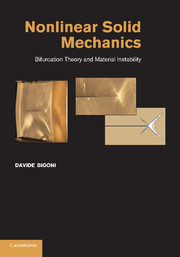Book contents
- Frontmatter
- Contents
- Preface
- Foreword by Giulio Maier
- 1 Introduction
- 2 Elements of tensor algebra and analysis
- 3 Solid mechanics at finite strains
- 4 Isotropic non-linear hyperelasticity
- 5 Solutions of simple problems in finitely deformed non-linear elastic solids
- 6 Constitutive equations and anisotropic elasticity
- 7 Yield functions with emphasis on pressure sensitivity
- 8 Elastoplastic constitutive equations
- 9 Moving discontinuities and boundary value problems
- 10 Global conditions of uniqueness and stability
- 11 Local conditions for uniqueness and stability
- 12 Incremental bifurcation of elastic solids
- 13 Applications of local and global uniqueness and stability criteria to non-associative elastoplasticity
- 14 Wave propagation, stability and bifurcation
- 15 Post-critical behaviour and multiple shear band formation
- 16 A perturbative approach to material instability
- References
- Index
- Plate section
11 - Local conditions for uniqueness and stability
Published online by Cambridge University Press: 05 August 2012
- Frontmatter
- Contents
- Preface
- Foreword by Giulio Maier
- 1 Introduction
- 2 Elements of tensor algebra and analysis
- 3 Solid mechanics at finite strains
- 4 Isotropic non-linear hyperelasticity
- 5 Solutions of simple problems in finitely deformed non-linear elastic solids
- 6 Constitutive equations and anisotropic elasticity
- 7 Yield functions with emphasis on pressure sensitivity
- 8 Elastoplastic constitutive equations
- 9 Moving discontinuities and boundary value problems
- 10 Global conditions of uniqueness and stability
- 11 Local conditions for uniqueness and stability
- 12 Incremental bifurcation of elastic solids
- 13 Applications of local and global uniqueness and stability criteria to non-associative elastoplasticity
- 14 Wave propagation, stability and bifurcation
- 15 Post-critical behaviour and multiple shear band formation
- 16 A perturbative approach to material instability
- References
- Index
- Plate section
Summary
Local conditions sufficient and necessary for the uniqueness of the rate boundary value problem, namely, positive definiteness and non-singularity of the constitutive operator, are presented. For homogeneous problems with displacement prescribed on the whole boundary, these become strong ellipticity of the Raniecki comparison solid and ellipticity of the in-loading comparison solid. Strain localisation is also explained in terms of ellipticity loss. Conditions for the onset of flutter instability are finally investigated.
From the uniqueness and stability criteria considered in the preceding chapter, local conditions may be derived, which are treated herein. The importance of local conditions lies in the connection to material instabilities, namely, to instabilities which can develop from a point in a continuum and therefore result independent of the boundary conditions. For instance, we will see that loss of ellipticity corresponds to shear band formation. The following five local criteria will be analysed in this chapter:
Positive definiteness of the constitutive operator (PD)
Non-singularity of the constitutive operator (NS)
Strong ellipticity (SE)
Ellipticity (E)
Flutter (F)
To begin providing an example of the preceding criteria in the simple case of the infinitesimal theory of isotropic elasticity, we recall the condition of positive definiteness (PD) [Eqs. (2.192)], which is the positiveness of the eigenvalues 2μ and λ + 2μ/3 of the elastic fourth-order tensor. Non-singularity (NS) corresponds to the condition of non-vanishing of these eigenvalues, and in a similar vein, strong ellipticity (SE) corresponds to the positiveness of the eigenvalues μ and λ + 2μ of the acoustic tensor (2.176), whereas ellipticity (E) corresponds to the non-vanishing of the same eigenvalues.
- Type
- Chapter
- Information
- Nonlinear Solid MechanicsBifurcation Theory and Material Instability, pp. 310 - 337Publisher: Cambridge University PressPrint publication year: 2012



